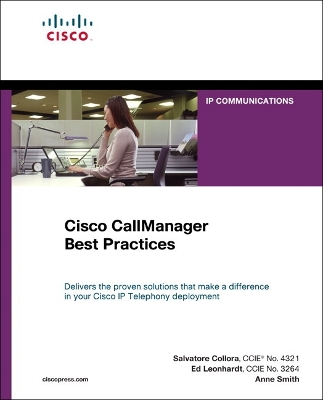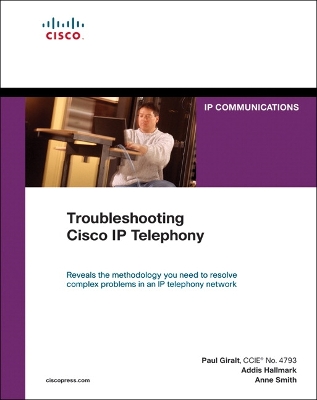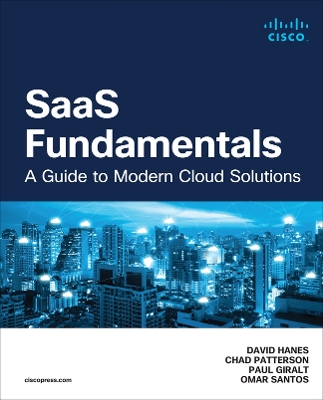Networking Technology
4 total works
Cisco CallManager Best Practices
by Salvatore Collora, Anne Smith, and Ed Leonhardt
Delivers the proven solutions that make a difference in your Cisco IP Telephony deployment
- Learn dial plan best practices that help you configure features such as intercom, group speed dials, music on hold, extension mobility, and more
- Understand how to manage and monitor your system proactively for maximum uptime
- Use dial plan components to reduce your exposure to toll fraud
- Take advantage of call detail records for call tracing and accounting, as well as troubleshooting
- Utilize the many Cisco IP Telephony features to enable branch site deployments
- Discover the best ways to install, upgrade, patch, and back up CallManager
- Learn how backing up to remote media provides both configuration recovery and failure survivability
IP telephony represents the future of telecommunications: a converged data and voice infrastructure boasting greater flexibility and more cost-effective scalability than traditional telephony. Having access to proven best practices, developed in the field by Cisco® IP Telephony experts, helps you ensure a solid, successful deployment.
Cisco CallManager Best Practices offers best practice solutions for CallManager and related IP telephony components such as IP phones, gateways, and applications. Written in short, to-the-point sections, this book lets you explore the tips, tricks, and lessons learned that will help you plan, install, configure, back up, restore, upgrade, patch, and secure Cisco CallManager, the core call processing component in a Cisco IP Telephony deployment. You’ll also discover the best ways to use services and parameters, directory integration, call detail records, management and monitoring applications, and more.
Customers inspired this book by asking the same questions time after time: How do I configure intercom? What’s the best way to use partitions and calling search spaces? How do I deploy CallManager regionally on my WAN? What do all those services really do? How do I know how many calls are active? How do I integrate CallManager with Active Directory? Years of expert experiences condensed for you in this book enable you to run a top-notch system while enhancing the performance and functionality of your IP telephony deployment.
Reveals the methodology you need to resolve complex problems in an IP telephony network
Master troubleshooting techniques and methodologies for all parts of a Cisco IP Telephony solution-Cisco CallManager, IP phones, gateways, applications, and more Learn how to investigate and resolve voice quality problems, including delayed audio, choppy or garbled audio, static and noise, one-way or no-way audio, and echo Read about the variety of trouble-shooting tools at your disposal and how and when to use them based on the problem type Discover the potential causes of common problems and how to efficiently troubleshoot them to resolution Learn how to identify and resolve gateway problems by breaking the components into logical groups and following a methodical troubleshooting approach Use best practices recommendations to build a stronger IP telephony deployment and avoid common mistakesIP telephony represents the future of telecommunications: a converged data and voice infrastructure boasting greater flexibility and more cost-effective scalability than traditional telephony. The ability to troubleshoot an IP telephony environment and the underlying network infrastructure is vitally important, just as it is in any complex system.
Troubleshooting Cisco IP Telephony teaches the troubleshooting skills necessary to identify and resolve problems in an IP telephony solution. This book provides comprehensive coverage of all parts of a Cisco IP Telephony (CIPT) solution, including CallManager, IP phones, gateways, analog devices, database and directory replication, call routing, voice mail, applications, network infrastructure, and more. You'll learn how to read trace files, determine when to turn on tracing and Cisco IOS(r) Software voice debugging, and how to troubleshoot voice quality issues.
Troubleshooting Cisco IP Telephony shows you how to break down problems to find the root cause. Descriptions of each part of the CIPT solution help you understand the functionality of each part of the solution and how each part interacts with other parts of the solution. You'll then learn what steps to take and tools to use to identify and resolve the cause of the problem.
Troubleshooting Cisco IP Telephony (paperback)
by Paul Giralt, Addis Hallmark, and Anne Smith
Master troubleshooting techniques and methodologies for all parts of a Cisco IP Telephony solution-Cisco CallManager, IP phones, gateways, applications, and more
Learn how to investigate and resolve voice quality problems, including delayed audio, choppy or garbled audio, static and noise, one-way or no-way audio, and echo
Read about the variety of trouble-shooting tools at your disposal and how and when to use them based on the problem type
Discover the potential causes of common problems and how to efficiently troubleshoot them to resolution
Learn how to identify and resolve gateway problems by breaking the components into logical groups and following a methodical troubleshooting approach
Use best practices recommendations to build a stronger IP telephony deployment and avoid common mistakes
IP telephony represents the future of telecommunications: a converged data and voice infrastructure boasting greater flexibility and more cost-effective scalability than traditional telephony. The ability to troubleshoot an IP telephony environment and the underlying network infrastructure is vitally important, just as it is in any complex system.
Troubleshooting Cisco IP Telephony teaches the troubleshooting skills necessary to identify and resolve problems in an IP telephony solution. This book provides comprehensive coverage of all parts of a Cisco IP Telephony (CIPT) solution, including CallManager, IP phones, gateways, analog devices, database and directory replication, call routing, voice mail, applications, network infrastructure, and more. You'll learn how to read trace files, determine when to turn on tracing and Cisco IOS(r) Software voice debugging, and how to troubleshoot voice quality issues.
Troubleshooting Cisco IP Telephony shows you how to break down problems to find the root cause. Descriptions of each part of the CIPT solution help you understand the functionality of each part of the solution and how each part interacts with other parts of the solution. You'll then learn what steps to take and tools to use to identify and resolve the cause of the problem.



